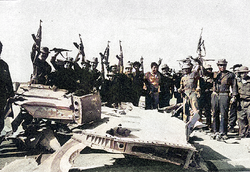Salamati-Khirmanian war
The Salamati-Khirmanian is a two-week war which opposed the countries of Salamat, led by Jalil Al Kharrabi and Khirmania, led by TBA.
Background
Although the relations between Khirmania and Salamat were hostile, tensions grew rapidly when a military coup installed Jalil Al Kharrabi who was a staunch islamist, as opposed to Khirmania's government.
Opposing forces
Khirmania
Salamat
Salamat was an authoritarian dictatorship ruled by the Mushir (Field Marshal) Jalil Al Kharrabi.
In the preceding years, Salamat had developed strong diplomatic ties with the communist country of Ezenchia, which granted him trade deals, including military equipment. At the same time, Salamat started developing its own indigenous military industry, although most of the weapons produced by Salamat at that time were pure copies of Riamese vehicles and weapons.
War
Invasion and offensive in Khirmania
At 0500 hours on July 3 1985, motorized vehicles, tanks and infantry crossed the border as a part of "Operation Hisan", which consisted of capturing the city of Al Hisan, also known as Isang, near the border.
The 8th infantry brigade and the 3rd division, however, were aiming for the coastal city of Baluang, which hosts a major port, making it an useful target.
The Salamati officers considered going on an all-in offensive on Mukarda, the Khirmanian capital, but the local geography would've made it difficult for the Salamati motorized formations to attain the capital.
At 1800 hours on July 4 1985, the Salamati and Khirmanian engaged in the first battle of the war, being the battle of the Ipan, named after the river bed which was disputed between the Salamati 1st division and the Khirmanian 7th brigade. Artillery shelling by the Salamati caused considerable damage to the city of Ipan, located 0,7 km (0,43 mi) northeast of the battlefield, and killed 11 civilians. Khirmanian artillery shelling, however, killed an estimated 150 soldiers in 6 hours. The battle would continue until a breach appeared in the Khirmanian frontline, forcing them to retreat north. At 0235 hours on July 5, the battle was a confirmed Salamati victory.
The Salamati troops in the south faced considerable resistance near Baluang, forcing them to retreat northward in the morning of July 5 1985.
Another battle emerged at 1300 hours on the same day, near the city of Al Hisan, in one of its suburbs named Bukilog, when the 17th armored battalion of Salamat encountered the 8th infantry battalion of Khirmania. This was the start of the battle of Bukilog.
Quickly, Khirmanian troops came to support the battalion, while Salamati troops were shelling the city from a field 0.9 km (0.56 mi) southwest of Bukilog. At 1440 hours, buildings of Bukilog started taking fire, and some Khirmanian troops were forced to retreat. Shortly after, Salamati troops advanced into the city, oddly with no resistance. At the same time, the Khirmanian encircled the city, and attempted an ambush, which failed. The battle evolved in an urban showdown, with troops hiding in houses and tanks driving in the streets of Bukilog. A group of Khirmanians then deserted, considering that the battle was long lost. Then, another Salamati battalion arrived as a support at 2100 hours, and stormed the city, cleaning it of most Khirmanian troops. The rest were forced to surrender, except TBA, which still remains as a symbol in Khirmania today.
At 0230 hours on July 6 , the battle was officially over and the Salamati won the battle of Bukilog.
On July 6, the Salamati advance began to slow down, with more resistance being encountered in the interior of the country. At 1200 hours on July 6, the Salamatis were only at 8 km from Al Hisan, and 32 km from Mukarda, the capital.
